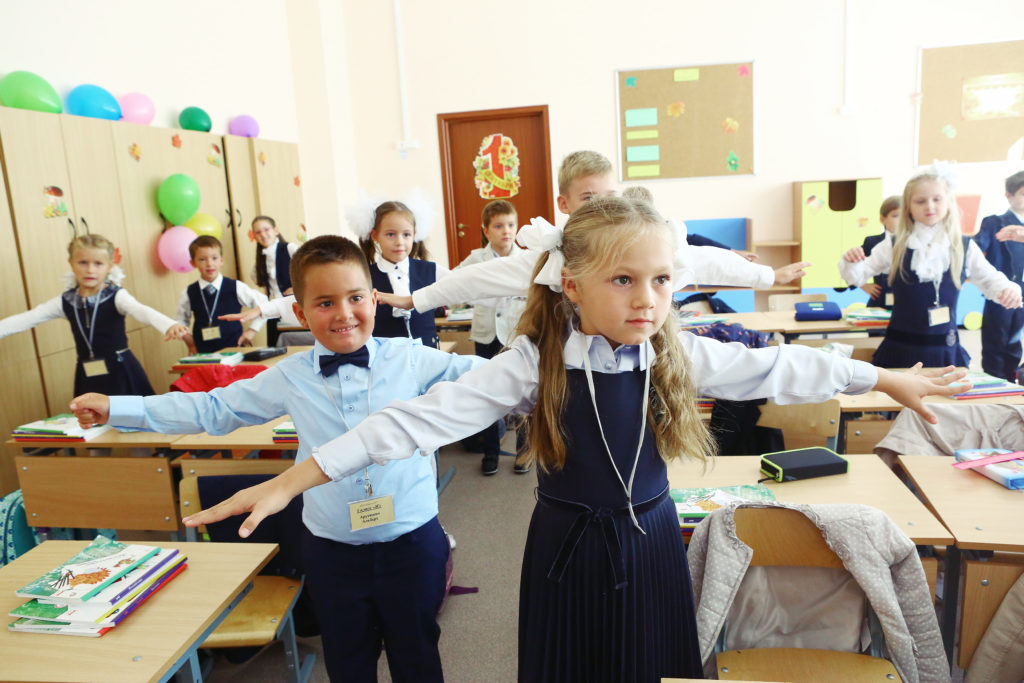General Information, Help for School and Kindy, Sensory Processing
6 Ways a Brain Break in the Classroom Can Help Children with Sensory Processing Disorder
Looking for ways to help your child with Sensory Processing Disorder to be more successful at school or with virtual classes?
Have you considered adding 6 minute brain breaks every 2 hours throughout the day to get kids moving with bain breaks in the classroom?
Here are 5 research-supported ways that a brain break or movement breaks in the classroom can help students that struggle with sensory processing disorder, learning difficulties, and attention deficits.

1. Brain breaks in the classroom make learning more efficient.
Research suggests that the part of the brain where memories are created (hippocampus) functions better at making long-term memories when there are short, “latent learning” breaks in between repetitions of new material.
So that would imply that taking a 5-minute brain breaks for students of any kind in between lessons would help students better absorb the material. And that’s not just for children with SPD – ALL students can benefit from a latent learning break!

2. They give students a chance to self-regulate their emotions.
Our kids are still learning how to manage their behavior and emotions – and some of us adults, too!
Now, it’s easy to imagine why self-regulation is important in social environments, including the classroom, but did you know that the ability to focus and follow directions are linked to a student’s ability to self-regulate?
Following directions, sitting still without blurting out or having an emotional outburst at every turn are all correlated with one’s ability to self-regulate. The best types of movement breaks in the classroom for regulation are proprioceptive activities.
Proprioception activities are types of movement that put a child into a weight-bearing posture (crawling, push-ups, etc.) or give resistance on joints, as well as pressure feedback. They’re also called heavy work activities.
Even in the moment, heavy work activities can be used as a quick emotional calming exercise. Providing strong proprioceptive input on the joints and muscles has been shown across the board to help calm children who are experiencing a sensory overwhelm.
That being said, ALL children benefit from proprioception activities, so they make a great addition to strategic brain breaks and movment in the classroom.

3. Fun brain breaks offer kids a mental and sensory break.
Focusing on classwork can be quite difficult for children experiencing sensory overwhelm. When their system has been in overwhelmed or focus mode for too long, teachers will notice higher rates of outbursts, acting out, and fidgeting.
A short brain break can help children re-centre, release tension, and break patterns of anxiety.
4. They improve focus and concentration.
Any type of exercise will get the blood circulating. That boost of oxygen to the brain improves focus and attention span. Additionally, though, certain proprioceptive activities can trigger alertness within the brain.
These types of activities are great for using as movement breaks in the classroom for teachers to regain the focus and attention of tiring students.
Vestibular stimulation activities, alternatively, target the vestibular system in the inner ear, which can be compromised in a wide range of developmental and sensory integration challenges.
The vestibular system is triggered with head movements. Coordination, balance, self-regulation of emotions and focus on tasks can all be strengthened with the practice of vestibular stimulation activities.
A common example is bending over at the waist and straightening back up again – anything that moves the head in drastically different directions.
Brainbreak that incorporate both proprioceptive and vestibular movements can make a significant improvement in students’ attention and sensory processing disorder symptoms.
5. Strategic brain breaks in the classroom can strengthen core muscles to counteract the bad postural habits of screen-time.
Because of the link between sensory-motor skills, physical coordination, and awareness of the body in space, I often see children with sensory processing disorder with weak cores.
Without proper core muscle strength, these children aren’t able to physically sit still at their desks in order to complete tasks or pay attention.
They also grow tired of handwriting assignments much faster. Many times, we can spot children struggling with this by the way they sit in class or at home during homework assignments:
- Sitting with a leg propped up in the chair or against the back of the desk in front of them.
- Fidgeting and having a hard time sitting still
- Laying their head on the desk or leaning their weight forward on their elbows most of the time
- Sitting on their knees
- Preferring to stand up or sit half on the seat, half off with the other foot on the ground for support

6. Challenging, targeted movement breaks in the classroom can build children’s confidence!
Piaget & Inhelder showed as early as 1969 that there is a correlation between physical proficiency in a variety of activities and perceptual learning.
So, by regularly challenging proprioceptive (perception) receptors in strategic movement breaks, children can become more confident in learning new activities. Alternatively, children whose proprioceptive system have not been challenged regularly are likely to be overwhelmed, exhausted, and frustrated, leading them to give up on challenging situations.
What Are Some Clever Ways to Incorporate Brain Breaks in the Classroom to Help Children with Sensory Processing Disorder?
1. Songs incorporate movement and learning, such as “Head, Shoulders, Knees and Toes,” which requires students to bend over many times. Older classes can practice the song in a different language each month – even sign language!
2. “Whole Body Learning” activities, such as those in which students bend over to pick up popsicle sticks or blocks with numbers and letters to spell words ohttp://whole bodyr solve math problems.
3. Hang a different number in each corner of the room, calling out a simple number problems, and asking the students to jump and turn to face the corner with the correct answer.
4. Store supplies under the students’ chairs. The child has to bend down to pick up pencils, crayons, erasers, etc.
5. Fetch the Box. The cutest example from teachers that I have heard of was a school in which teachers utilized a heavy box as a heavy work tool.
Whenever a teacher saw a child in need of movement and heavy muscle work, they would ask the child to take the box to another classroom. And so, the mystery box travelled from class to class, being fetched for a teacher from the principal or hauled to the principal’s office.
So long as the teachers could keep the mystery a secret, the box errand worked. But as soon as someone let the cat out of the bag – or box, in this case – the schtick was up!
6. Erasing chalkboards/dry erase boards. That is, if your classroom still uses these types of board! The movements are great for proprioceptive feedback to the shoulders and waist. Kids love to do it, and teachers love to have the help!
7. Chair stacking / Moving Stools. If your classroom uses various stations or re-stages one room for various purposes throughout the day, assign a pair of students to be in charge of stacking and moving chairs each day.
9. Holding open the door. Each day, assign the leader of the line with the responsibility of holding doors open for all students anytime you change classrooms.
10. Make the hallway an exercise course. Any time you change rooms, have students alternate between hopping on two feet to lunging from one foot to the next, or squatting low and hobbling in a squat. Any of these types of brain break activities add a little bit of proprioceptive feedback to their joints.
CoordiKids Classroom Course – The 5-minute Brain Breaks for Kids Video Series that Targets Proprioceptive & Vestibular, Sensory and Motor Systems

Above: Just two of the games in the CoordiKids Classroom Course sequences that offer proprioceptive feedback – jumping in different directions like a quick rabbit, and a hopping challenge from foot to foot!
Become a CoordiKids member today to start using the Classroom Course daily activities today to start helping your child with sensory processing disorder.
The CoordiKids Classroom Course utilizes easy-to-follow videos of exercises in which the focus is on body movements, giving the cortex (thinking brain) a break to refresh, and get ready to concentrate.
However, the exercises are fun for all participating children, get their muscles moving, oxygen flowing to the brain, and require no additional prep time from the teacher. He or she simply starts one of the online videos, and the class can follow along.
(The teacher or any adult can join in to experience the same benefits!)
CK Classroom Course has essential elements of movement, listening, brain bridging (including crossing the midline of the body) and more specific targets to ensure optimal attention after over 5 minutes.
A great way to introduce the CoordiKids Classroom brain breaks is to introduce them during staff meetings. Just look at the reaction of average adults after participating in these easy-to-follow exercises, and you’ll see the benefits your students will have as well!
Pingback: Listening Activities for Kids: Teaching Students to Follow Directions
Pingback: "Why is it That My Child Can’t Sit Still?" – Here's How to Help - CoordiKids
Pingback: Mindfulness in the Classroom : Middle School and Older - CoordiKids
Pingback: A surprisingly easy way to help Attention Deficits and ADHD sensory issues
Pingback: Developmental Co-ordination Disorder (Dyspraxia)
Pingback: Famous people with ADHD
Pingback: ADHD in the Classroom: How to Keep Your Cool and Your Kids on Track
Pingback: ADHD in Girls vs Boys
Pingback: Unlocking Laser-Like Focus: A Parent's Guide to Boost Attention and Focus - CoordiKids